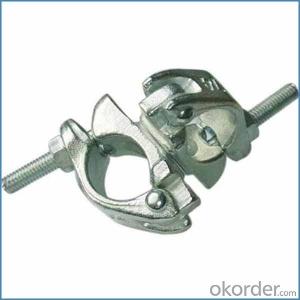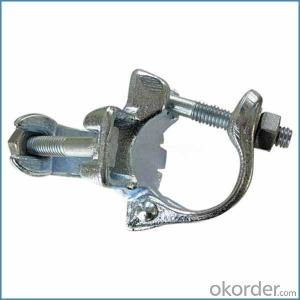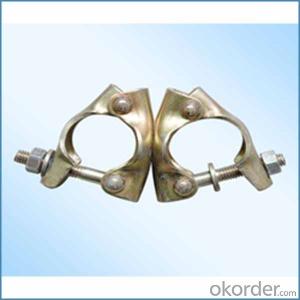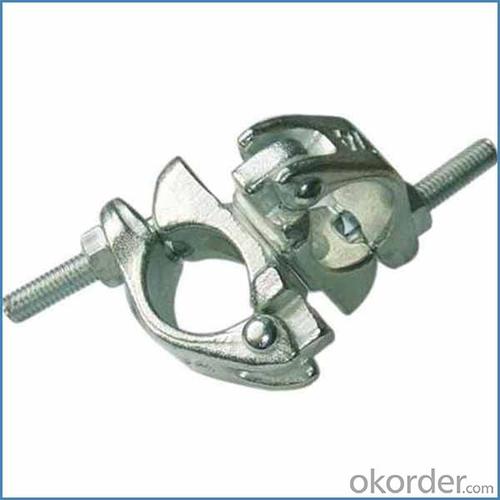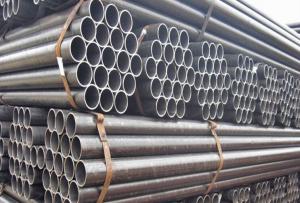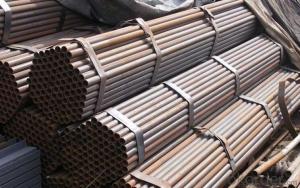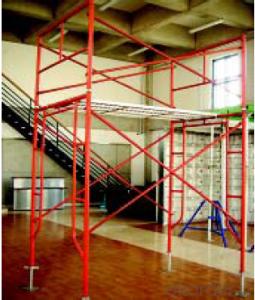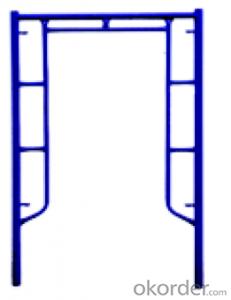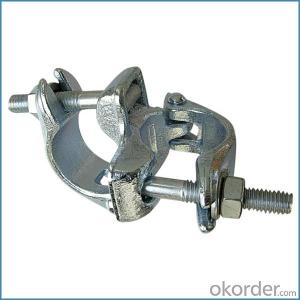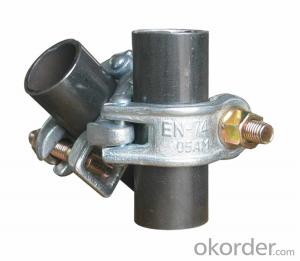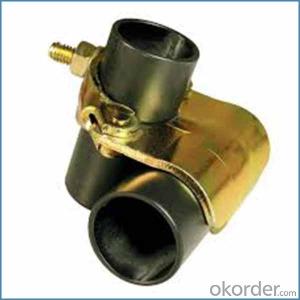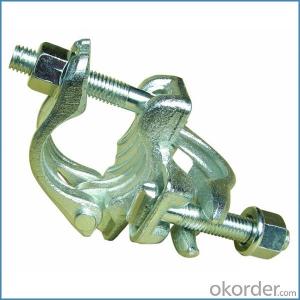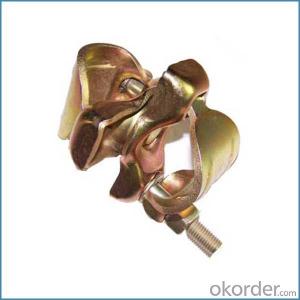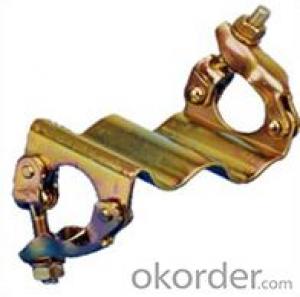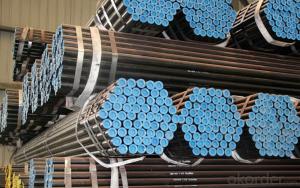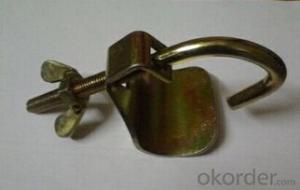Scaffolding Fixed Clamp british German Forged Type
- Loading Port:
- Tianjin
- Payment Terms:
- TT OR LC
- Min Order Qty:
- 1000 kg
- Supply Capability:
- 100000 kg/month
OKorder Service Pledge
OKorder Financial Service
You Might Also Like
Scaffolding Fixed Clamp british German Forged Type
Description
1.The scaffolding coupler is always used to connect the steel pipe as scaffolding system.
2.The often used coupler is swivel coupler and righ angle coupler .
3.We can provide types of scaffolding coupler according to your requirement.
4.Couoler can fix the 48.3mm scaffolding steel pipe tightly and make the whole scaffolding system more steadily.
Feature
(1)Excellent Anti-Breaking—Cold Pressed Steel
(2)Outstanding Resistance Deformation
(3)Strong Anti-Dropping Ability
Photo

Parameter
| Material | Q235,345steel |
| Size | 48.3mm*48.3mm |
| Surface finish | Galvanized |
| Weight | 1.1kg around |
| Standard | BS1139,EN74 |
| Package | 25pcs/bag,steel pallet |
| Manufacture | As per customer requirement |
| Market | Africa, South America, the Middle East and Asia |
FAQ
Q: Are you a factory or trading company?
We are a state-owned corporation in China,dealing with various kinds of building materials.We have our holding subsidiaries.
Q: Where is your factory located? How can I visit there?
Our factory is located all around China.
Q: Can I get some samples?
Sample is free, customer only pay freight for the first time.
Q: Delivery?
10-30days. (5-15 containers)
Any question,feel free to contact us.
- Q: How do steel tube couplers contribute to the overall safety of a scaffolding structure?
- Steel tube couplers contribute to the overall safety of a scaffolding structure by providing a secure and reliable way to connect and secure the tubes together. These couplers are designed to withstand heavy loads and prevent any movement or disconnection of the tubes, ensuring the stability and integrity of the scaffolding. By eliminating the risk of structural failure or collapse, steel tube couplers enhance the safety of workers and anyone accessing the scaffolding, providing a stable and secure platform for construction and maintenance activities.
- Q: How do you ensure proper stability when using steel tube couplers in scaffolding?
- To ensure the proper stability of scaffolding when using steel tube couplers, it is important to follow several key steps: 1. Select suitable couplers: Choose couplers that are specifically designed for scaffolding applications and are compatible with the size and type of steel tubes being used. It is crucial to use well-designed and high-quality couplers to guarantee stability. 2. Install correctly: Ensure the couplers are installed properly on the steel tubes. This involves securely tightening the couplers using the recommended torque settings. It is essential to adhere to the manufacturer's instructions and guidelines for correct installation. 3. Conduct regular inspections: Regularly inspect the couplers and the entire scaffolding system to identify any signs of damage, wear, or loosening. This should include checking for cracks, deformations, or signs of corrosion on the couplers. If any issues are found, replace the affected couplers immediately. 4. Provide adequate bracing: Use sufficient bracing to offer additional support and stability to the scaffolding structure. This can involve adding diagonal braces or securing the scaffolding to a sturdy structure, depending on the project's specific requirements. Bracing helps evenly distribute the load and minimize the potential for instability. 5. Consider load capacity: Ensure that the scaffolding system is designed and constructed to handle the expected loads. This involves considering the weight of workers, equipment, and materials that will be placed on the scaffolding. Exceeding the scaffolding's load capacity can result in instability and potential collapse. 6. Comply with safety standards: Follow the relevant safety standards and regulations set by local authorities and industry organizations for scaffolding construction and use. These standards often provide specific guidelines for the use of steel couplers in scaffolding and can help ensure proper stability. By following these steps and maintaining proper installation, inspection, and compliance with safety standards, you can ensure the proper stability of scaffolding when using steel tube couplers. Prioritizing safety and taking necessary precautions are vital to protecting workers and preventing accidents or collapses.
- Q: Can steel tube couplers be used in scaffolding structures with specialized requirements, such as protection against seismic activity?
- Yes, steel tube couplers can be used in scaffolding structures with specialized requirements, including protection against seismic activity. Steel tube couplers are known for their strength and durability, making them suitable for withstanding seismic forces. Additionally, their flexibility allows for easy assembly and disassembly, making them a practical choice for scaffolding structures in areas prone to seismic activity.
- Q: What is the process for connecting steel tube couplers to scaffolding tubes?
- Connecting steel tube couplers to scaffolding tubes requires a series of steps. To begin, it is crucial to ensure that both the scaffolding tubes and steel tube couplers are clean and devoid of any dirt or debris. This will guarantee a secure and stable connection. Next, properly position the steel tube coupler onto one end of the scaffolding tube, making sure it aligns correctly with the holes in the tube. Once the coupler is in place, firmly strike the side of the coupler with a hammer. This action will prompt the teeth or wedges on the inside of the coupler to grip onto the scaffolding tube, resulting in a robust connection. Repeat this process for the other end of the scaffolding tube, connecting it either to another steel tube coupler or to the scaffolding structure itself. It is vital to ensure that the couplers are adequately tightened and secured to the scaffolding tubes. This can be achieved by utilizing a spanner or wrench to tighten the bolts or nuts on the coupler. Regularly inspect the connections to verify their security and tighten them further if necessary. Additionally, it is important to adhere to any guidelines or recommendations provided by the manufacturer for the specific type of steel tube couplers being utilized. Overall, the process for connecting steel tube couplers to scaffolding tubes involves sliding the coupler onto the tube, hammering it to establish a secure grip, and then tightening it further with a spanner or wrench.
- Q: Are steel tube couplers suitable for scaffolding projects requiring frequent movement or relocation?
- Yes, steel tube couplers are suitable for scaffolding projects requiring frequent movement or relocation. Steel tube couplers are known for their durability, strength, and versatility, making them ideal for scaffolding projects that require frequent assembly and disassembly. They provide a secure and stable connection between scaffolding tubes, ensuring the safety and stability of the structure while allowing for easy dismantling and relocation.
- Q: What safety measures should be taken when working with steel tube couplers in scaffolding?
- To ensure the safety of workers and prevent accidents when working with steel tube couplers in scaffolding, it is crucial to implement several safety measures. Consider the following key precautions: 1. Training and Competency: Workers must undergo comprehensive training and demonstrate their competence in working with steel tube couplers. This includes understanding their correct usage, installation techniques, and potential hazards associated with scaffolding. 2. Inspection and Maintenance: Regularly inspecting steel tube couplers is essential to identify any signs of wear, damage, or corrosion. Any damaged or faulty couplers should be promptly replaced to maintain the overall structural integrity of the scaffolding. 3. Load Capacity: It is vital to comprehend the load capacity of both the steel tube couplers and the scaffolding system in use. Overloading can result in collapse or failure, leading to severe injuries or fatalities. Always adhere to the manufacturer's guidelines and consult a structural engineer if necessary. 4. Secure Connections: Properly securing the connections of steel tube couplers is crucial for maintaining stability. Ensure that the couplers are tightly fastened and that there is no movement or looseness in the connections. Loose or improperly secured couplers can cause accidents or make the scaffold unstable. 5. Fall Protection: Workers should be equipped with appropriate fall protection equipment, such as harnesses and lanyards, when working at heights. Additionally, install guardrails and toe boards on scaffolding platforms to prevent falls and ensure a safe working environment. 6. Stability and Base Support: Erect scaffolding on a stable and level surface. Properly position and secure the base plates or adjustable jacks to prevent any movement or instability during use. 7. Communication and Signage: Clear communication among workers is crucial to avoid accidents. Use proper signage, such as warning signs and barricades, to mark areas where scaffolding is in use and to inform others to keep a safe distance. 8. Weather Conditions: Take into account the impact of weather conditions on scaffolding stability. Strong winds, rain, or snow can significantly affect the safety and stability of the scaffolding. Regularly check weather forecasts and take appropriate measures to protect against adverse conditions. 9. Personal Protective Equipment (PPE): Workers must be provided with and wear suitable PPE, such as hard hats, safety glasses, gloves, and appropriate footwear, to protect against potential hazards associated with steel tube couplers. By adhering to these safety measures, workers can minimize the risk of accidents, ensure the structural integrity of scaffolding, and create a safe working environment when using steel tube couplers.
- Q: What are the common methods of securing steel tube couplers to scaffolding tubes to prevent accidental rotation or twisting?
- To prevent accidental rotation or twisting, different methods can be used to secure steel tube couplers to scaffolding tubes. These methods include: 1. Utilizing gravity: By positioning the coupler in a specific way that evenly distributes its weight, it can create a stable connection that resists rotation or twisting. This method is commonly employed with swivel couplers. 2. Employing a hammer: By forcefully striking the coupler, it can be tightly secured onto the scaffolding tube, minimizing any potential rotation or twisting. Caution must be exercised to avoid damaging the coupler or the tube. 3. Using bolt and nut fastening: This involves inserting a bolt through the holes of the coupler and then tightening it with a nut. This creates a strong and secure connection that prevents any accidental rotation or twisting. Proper tightening is essential for maximum stability. 4. Utilizing built-in locking pins: Some couplers have locking mechanisms that use pins to secure the connection. These pins are inserted through holes in both the coupler and the scaffolding tube, creating a locked position that prevents rotation or twisting. This method offers a quick and convenient way to secure the coupler without additional tools or equipment. 5. Applying wedges or clamps: Wedges or clamps can be inserted between the coupler and the tube and then tightened, creating a strong grip that prevents accidental rotation or twisting. This method is particularly useful for establishing a secure connection quickly and easily. It is important to note that the specific method chosen may depend on the type of coupler and scaffolding system being used. Following the manufacturer's guidelines and recommendations is crucial for proper and secure installation of the couplers. Regular inspections and maintenance should also be conducted to ensure the connection remains secure throughout the duration of scaffolding use.
- Q: Can steel tube couplers be used in different scaffolding systems?
- Steel tube couplers have the capability to be utilized in diverse scaffolding systems. Their versatility allows for the connection of tubes in various scaffolding configurations. Tube and clamp scaffolding systems frequently employ steel tube couplers, which are utilized to connect tubes at right angles, resulting in the formation of a scaffold structure. Moreover, steel tube couplers can also be employed in alternative types of scaffolding systems, including ringlock scaffolding or cuplock scaffolding, to securely link tubes and establish a stable platform for workers. The robustness and long-lasting nature of steel tube couplers make them ideal for integration into different scaffolding systems, thus guaranteeing the safety and stability of the structure.
- Q: Are steel tube couplers suitable for scaffolding projects with complex and intricate designs?
- Yes, steel tube couplers are suitable for scaffolding projects with complex and intricate designs. Steel tube couplers offer a strong and versatile connection between scaffolding tubes, allowing for various angles and configurations. This flexibility makes them ideal for accommodating complex and intricate scaffolding designs, ensuring stability and safety in the construction project.
- Q: How do you ensure proper weight capacity when using steel tube couplers in scaffolding?
- To guarantee the appropriate weight capacity while employing steel tube couplers in scaffolding, various crucial factors necessitate consideration and adherence: 1. Adherence to manufacturer's guidelines: Strict adherence to the manufacturer's guidelines for the specific steel tube couplers in use is of utmost importance. These guidelines provide vital information regarding weight capacity, proper usage, and limitations. 2. Calculation of loads: Prior to erecting the scaffolding, it is essential to calculate the anticipated load that the scaffolding will bear. This calculation should take into account not only the weight of workers and materials but also any dynamic loads that may arise during the work process. 3. Proper installation: The correct installation of the steel tube couplers is pivotal in maintaining weight capacity. The couplers must be securely tightened to ensure a robust connection between the tubes. It is essential to employ the appropriate size and type of couplers in accordance with the manufacturer's recommendations. 4. Regular inspections: Regular inspections of the scaffolding are necessary to identify any signs of wear, damage, or overloading. Any couplers that are damaged or worn-out should be promptly replaced to preserve the integrity and weight capacity of the scaffolding. 5. Correct utilization of bracing and ties: Employing bracing and ties is crucial in providing additional stability to the scaffolding system. These components aid in evenly distributing the weight and preventing excessive movement or swaying that might compromise the weight capacity. 6. Training and supervision: Workers should receive adequate training on the safe utilization of scaffolding and steel tube couplers. They must be aware of the limitations in weight capacity and comprehend the significance of adhering to guidelines and best practices. Appropriate supervision should be in place to ensure compliance with safety procedures. By adhering to these practices, one can ensure the proper weight capacity when utilizing steel tube couplers in scaffolding, thereby fostering a safe working environment and minimizing the risk of accidents or structural failure.
Send your message to us
Scaffolding Fixed Clamp british German Forged Type
- Loading Port:
- Tianjin
- Payment Terms:
- TT OR LC
- Min Order Qty:
- 1000 kg
- Supply Capability:
- 100000 kg/month
OKorder Service Pledge
OKorder Financial Service
Similar products
Hot products
Hot Searches
Related keywords
